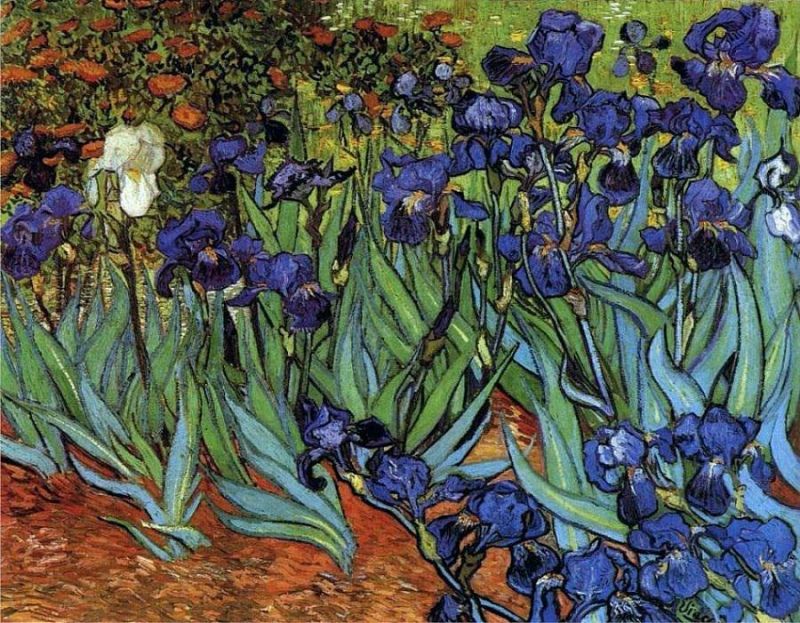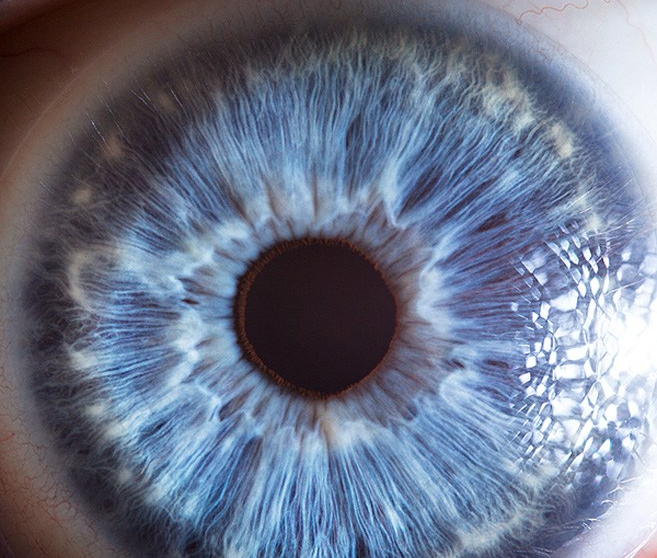Irises: Shape-shifters and Magical Reinventors
"In grocery stores iris buds are bundled together, like perfectly sharpened purple-pointed pencils, like slender indigo-edged spears, like a quiver of Spring arrows poised to unbend unhappy bents of mind. Take a sheaf home, place it in a glass vase and by morning, from poised purple-tipped silence, spill sepals and petals frothy with filaments and ruffles, loquacious little fountains self-released into sunshine, newly aware of the greater world.
An iris in a bud understandably assumes the bud is the world. An iris outside its bud is suddenly adrift. Its erstwhile home is gone, irretrievable, like misspent youth or last Wednesday's sunset. Yet this turn of events does little to disturb an iris's equanimity. Unlike many mortals, irises are not unsettled by dramatic changes in circumstance. Perhaps this is because they cradle memories of their ancestors, who fell asleep in autumnal earth as knobbly rhizomes or bulbous bulbs, only to dream and wake some seasons later, tall, slender, studded with purple possibilities, and brandishing green leaves like pirate swords."
That swimming, sloping, elusive something about the dark-bluish tint of the iris which seemed still to retain the shadows it had absorbed of ancient, fabulous forests where there were more birds than tigers and more fruit than thorns, and where, in some dappled depth, man’s mind had been born. –Vladimir Nabakov
Who would deduce the dragonfly from the larva, the iris from the bud, the lawyer from the infant? …We are all shape-shifters and magical reinventors. Life is really a plural noun, a caravan of selves. –Diane Ackerman
In truth that which we call an iris is not a flower at all, but a fan-shaped inflorescence–a small tribe of flowers arranged on a common stem (hilariously called the peduncle). In other words the iris is a community, not an individual. Any iris who thinks otherwise labors prettily under a delusion. We must not hold this against them (people who live in glass houses etc). Hardy and international in spirit, irises thrive in a variety of terrains; semi-desert land, rocky mountain ridges, grassy slopes, meadows, bogs, and riverbanks. Traversing the yawn of centuries they have covered great distances leaving their petal prints on history, tradition, medicine, cosmetology, commerce and more.
Greek and Roman apothecaries prescribed iris seeds for ancients with indigestion, and unguents of iris were slathered onto battle wounds. Unguents. Please note how appropriately viscous that word is, how it sticks faithful like peanut butter to the roof of your mouth. Egyptians creatively extracted exotic perfume from dried iris rhizomes (called orris root), which are incidentally also used to flavor gin. Peeled orris root gives off the delicious scent of violets. It was crushed and commonly used in baby powder, wig powder and toothpaste because, scent of violets. In Croatia the iris is named after the head of the Slavic pantheon, Perun, God of Thunder. Perunika grows wherever his lightning bolts strike the Earth, a tender compensation. In Kashmir the white iris kashmiriana is often planted on Muslim graves, a custom that stretches into Turkey and beyond. In medieval Florence where white irises grew out of the city walls, the fleur-de-lis, a stylized version of the blossom, became an emblem of the city. In 12th century France Louis VII deployed it on his standard. In post-Katrina New Orleans people tattooed themselves with it, a symbol of unity, renewal, resilience.
The fleur-de-lis, just so you know, is modeled on the blooms of a bearded iris. For irises can be bearded, beardless, or crested. There are dwarf bearded irises and tall bearded irises. There are also redundantly-named miniature dwarf bearded irises and oxymoronically-named miniature tall bearded irises. There are approximately as many kinds of irises as there are days in the year, and their names are often as enticing and enigmatic as the names of paint shades, racing horses and seaworthy vessels. Vesper, Ghost Writer, Gambling Man. Thornbird, Florentina, Autumn Jester, Pagan Dance, Parting Glances, Dusky Challenger, Early Light, Lady Friend, Petticoat Shuffle, Here Be Dragons, Let Evening Come.

Van Gogh’s Irises, Saint-Remy, c 1889
What in your life is calling you, When all the noise is silenced, The meetings adjourned… The lists laid aside, And the wild iris blooms by itself in the dark forest… What still pulls on your soul? –Rumi
In the Springtime of 1889, after multiple bouts of self-harm and
hospitalization, Vincent Van Gogh voluntarily admitted himself into an
asylum. His first week there he began one of his most famous works of
art. “Irises” depicts a corner of the asylum garden. Vivid, abrupt,
intimate, unsettling. Van Gogh’s vision unveils the incessant,
unappeasable, grandeur of movement that always and ever denies the
possibility of "still life." The colossal dance of the cosmos reflected
in leaf and grain, water, star and sunflower alike. The lone white iris
in this multi-million-dollar masterpiece quiet, ghostly, offset in a
roiling sea of color, has led to much conjecture. It steals into the
heart like a gentle hand staying you a moment from the careless cares of
the day, giving you perhaps a comet-swift inkling of what it might be
like to look on this world through Van Gogh’s eyes, to carry like a
cross the burden of its beauty. And perhaps it is not accidental that
the iris is known in many places as the Sword lily, or Mary’s Sword of
Sorrow. Over the next year (the last of his life) Van Gogh created close
to 130 paintings. When he died he took the secret of the white iris
with him to his grave.

Photo by Pellinni at Morguefile.com
“Now Thaumas married a daughter of deep-running Okeanos (Oceanus), Elektra (Electra), and she bore him swift-footed Iris, the rainbow.” – Hesiod, Theogony (trans. Evelyn-White)
In Greek mythology Iris is a minor goddess. Yes, someone saw fit to pull rank on celestial beings this way–Ursa Major and Ursa Minor are another case in point. One might surmise that to be a minor goddess is to be an oxymoron. Akin to being a minor apocalypse. But no. Being a heavenly resident doesn’t automatically make you a big deal. Some heavenly deals are apparently bigger than others and if you are others then you are automatically a minor deal. That is how it goes more often than not in the cosmos, at least until we know better (which is hopefully soon). But back to Iris, deemed (for now at least) a minor goddess of the Greeks. Luminous daughter of a marine god, and a cloud nymph, begat by sea and sky, the joy of all who beheld her.
In statues, paintings, poems and dreams, Iris is shapely of form, sparkling of eye, pitchered of hand. The ancients believed she used this convenient container to replenish the rain clouds with water from the sea. When not in use restocking clouds with their silvery wares, this pitcher was sometimes dispatched, and Iris with it, by Zeus (who among the Greek pantheon does by far, the lion’s share of dispatching), to collect water from the river Styx, solely for the purpose of testing a dubious god’s (or goddess’s) veracity. Divine being or not, speak falsely under oath of the water Styx and you will be rendered unconscious for a year, and then barred for nine years after from any and all godly feasts, festivities, boardrooms, conferences, and meet ups (a much dreaded punishment, for apparently even the gods require a thriving social network for healthy self-esteem.)
Perhaps, on a day when all the clouds were brimful and all deities were trustworthy, coastal Greeks saw Iris temporarily unemployed, a lovely young lady of leisure, reaching a hand out to each of her parents, and skipping between them on a rainbow arch, connecting this realm with another. A bridge between worlds, a radiant presence and a possibility. And so it was perhaps that she became Iris of the Rainbow, entrusted with tenderly chaperoning the departed from our world to the next. And you must admit, regardless of what you believe about the afterlife, that if one must eventually make the journey (and one must), from this spinning Earth with its dolphins, and doughnuts, its rickshaws and rhododendrons, its tightrope walkers, weather reports and wireless routers, to an undisclosed destination, then there is no better way to do it than on the gleaming curve of a rainbow, accompanied by a minor goddess who has never let a cloud go thirsty.
Because they are beautiful and shimmer with all the colors of the rainbow (save for true red), iris flowers are the goddess’s namesake. It became customary to plant iris flowers on the graves of young women who had died, as a way of inviting divinity’s presence on the journey to the hereafter. Because these flowers are perennials, they rise from the sleeping earth each year, floral resurrections. At a time when the language of irises seems all but forgotten, they pierce the soil with their proud, pointed leaves, their stems bearing angled buds, from which extraordinary flowers babble forth. When the world speaks in green tongues it is hard not to be baffled and beguiled. Irises remind the world that presence and absence are inseparable. That which arrives is always departing, and that which departs is always and also arriving.
Under this fine rain I breathe in the innocence of the world. I feel coloured by the nuances of infinity. At this moment I am one with my picture. We are an iridescent chaos. – Paul Cezanne
If you have ever glimpsed a rainbow shimmering in an oil slick, a hummingbird’s throat, a butterfly wing, peacock feather or a soap bubble you have witnessed iridescence. This quality of being rainbow-like has its roots in the word iris.
Some words are ill-chosen, like pulchritude, which means beauty but sounds more like a type of stomachache, or an unpleasant taste in one’s mouth. Other words are perfectly chosen, fitting their meaning like a snail fits her shell, like extravaganza, discombobulation, and iridescence.
Iridescence is born when light encounters certain physical structures whose features cause its waves to stumble into one another. The way encountering certain kinds of beauty can cause us to fumble for words, forget how to properly use our feet, and fling ourselves headlong into sidewalk shrubbery. Science calls this phenomenon interference and it is of two types; destructive and constructive. Destructive interference occurs when the crests and troughs of the stumbling waves cancel each other out, dimming their reflected light. This is akin to the type of interference humans encounter in the form of meddling relatives and heavy-handed upper management. In constructive interference, the crests and the troughs of the stumbling waves line up together perfectly. Light waves superimposed in this way reinforce and vivify one another, heightening the vibrancy of their reflected color. That which was moderately red, for instance escalates into the very reddest of reds, the epitome of redness. The way soulmates meeting suffuse into the very them-est versions of themselves. Because these two types of interference happen simultaneously, like a dance floor filled with a random combination of incredibly uncoordinated dancers and phenomenally synchronized ones, as the viewer’s viewing angle shifts, the colors of the iridescent object seem to skitter and slide unpredictably towards muting or muchness depending on the varying degrees of destructive and constructive interference at play.

Photo by Suren Manvelyan
This unlikely story begins on a sea that was a blue dream, as colorful as blue-silk stockings, and beneath a sky as blue as the irises of children’s eyes. – F. Scott Fitzgerald
Regardless of where you behold iridescence in the world, you behold it through your iris– the flat, ring-shaped membrane whose varied tints recall to mind the rainbow, hence its name. Composed of connective tissue and muscle the iris responds to the play of light by contracting or relaxing to narrow or broaden the window through which light voyages from our outer world and vanishes into our inner one, setting intricate spirals of synaptic dominoes tumbling, giving rise to a furiously rich and entangled set of notions and emotions exponentially faster than the fastest among us can spit out lickety-split.
Look closely into the eyes of your beloved, your cat, your postman or the traveler seated next to you on the bus, and you will fall into a mysterious, mapless universe, gorgeous in its strangeness and filled with unique landmarks bearing names more worthy of Tolkien than medical textbooks. The topography of the iris is as weird and wonderful as any undiscovered alien planet you can conjure in your imagination.
Fusch’s crypts are the areas that look like furrows, the places where seedlings would be planted if you were considering planting seedlings in your iris, they are places where collagen fibers are less dense. The white spots are Wolfflin nodules — which sound like something an irate wizard might inflict on you but are in reality simply hotspots of collagen fibers. The dark spots that look like tiny black holes in a small galaxy are Nevi and the product of a localized increase in pigment production. And no I am not making any of this up. Cross my heart, hope to fly.
A Google search might tell you that iris recognition is “an automated method of biometric identification that uses mathematical pattern-recognition techniques on video images of one or both of the irises of an individual’s eyes, whose complex patterns are unique, stable and can be seen from some distance.” You may also learn that there are now several hundred million persons across several countries in our world who have been enrolled like schoolchildren in summer camp, in iris recognition systems for “convenience purposes."
What a Google search will not tell you is that we are inlaid with iris recognition systems that glint within us as gorgeously as rubies in a Mughal scabbard. Iris recognition systems will stop you on a Spring sidewalk to stare at and sip from a clutch of flowers despite the formidable length of your to-do-list, and the considerable heft of your responsibilities. Iris recognition systems will lightly toss your heart like a beating golden ball into your throat when you catch sight of a rainbow arching like a runaway poem across a prosy sky. Iris recognition systems will make you count the jeweled flash of a hummingbird’s throat when you are tallying up your bounty of blessings, will drop you down a never-ending chute into the heart of the heart of your heart as you gaze into the supernatural landscape of another’s gaze, will fill you with pleasure so utter it brushes the border of pain, and teaches for once and all time the relatedness of every one and every thing.
